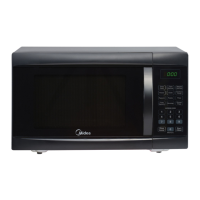APPLICABLE COOKING UTENSILS
See the instructions on "Materials you can use in microwave oven or to be avoided in
microwave oven." There may be certain non-metallic utensils that are not safe to use
for microwaving. If in doubt, you can test the utensil in question following the
procedure below.
Utensil Test:
1. Fill a microwave-safe container with 1 cup of cold water (250ml) along with the
utensil in question.
2. Cook on maximum power for 1 minute.
3. Carefully feel the utensil. If the empty utensil is warm, do not use it for microwave
cooking.
4. Do not exceed 1 minute cooking time
Materials you or to be avoided on Microwave Oven
Utensils Remarks
Aluminum foil Shielding only. Small smooth pieces can be used to cover
thin parts of meat or poultry to prevent overcooking.
Arcing can occur if foil is too close to oven walls. The foil
should be at least 2.5cm away from oven walls.
Browning dish Follow manufacturer’s instructions. The bottom of
browning dish must be at least 5mm above the turntable.
Incorrect usage may cause the turntable to break.
Dinnerware Microwave-safe only. Follow manufacturer's instructions.
Do not use cracked or chipped dishes.
Glass jars Always remove lid. Use only to heat food until just warm.
Most glass jars are not heat resistant and may break.
Glassware Heat-resistant oven glassware only. Make sure there is no
metallic trim. Do not use cracked or chipped dishes.
Oven cooking
bags
Follow manufacturer’s instructions. Do not close with
metal tie. Make slits to allow steam to escape.
Paper plates
and cups
Use for short–term cooking/warming only. Do not leave
oven unattended while cooking.
Paper towels Use to cover food for reheating and absorbing fat. Use
with supervision for a short-term cooking only.

